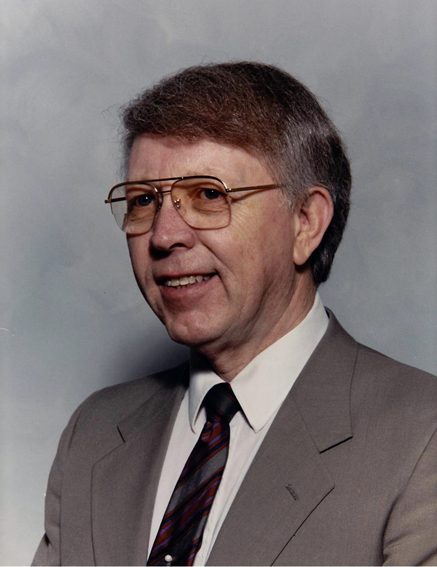In Memoriam: Robert E. (Bob) Alexander
1928-2014
by Ronald L. Kathren, CHP

For the second time in this comparatively young year, the Health Physics Society (HPS) has lost a past president with the death of Robert E. (Bob) Alexander from a stroke on 12 February 2014 in Alexandria, Virginia, after a six-year battle with Parkinson's disease and dementia. Bob was born on 10 December 1928, in Amarillo, Texas, and maintained his soft-spoken Texas drawl throughout his entire life. Bob received a BA in premedical studies from Howard Payne College (now Howard Payne University) in 1954 and pursued graduate courses in mathematics at several other educational institutions in subsequent years while employed full time. He was certified by the American Board of Health Physics and was an active member of the American Academy of Health Physics.
Bob began his career in operational health physics, working first at Convair in Fort Worth, Texas, and subsequently as a radiological engineer and manager at Atomics International in Southern California. Subsequently, Bob served as a health physics advisor to Indonesia and Greece for the International Atomic Energy Agency and as chief in the Environmental Health Branch of the National Aeronautics and Space Administration (NASA) before joining the U.S. Atomic Energy Commission as a staff health physicist. When the Nuclear Regulatory Commission (NRC) was formed, he was appointed chief of the Occupational Radiation Protection Branch in the Office of Nuclear Regulatory Research and was elevated to the Senior Executive Service when it was established.
As NRC branch chief, Bob successfully led a group of freethinkers, guiding them into a cohesive, highly productive body through his unique management style that included annual satirical Christmas shows about NRC management. Under his leadership, NRC formulated the as low as resonably achievable (ALARA) policy, and in 1991 NRC published the comprehensive revision of the basic regulation, Title 10, Code of Federal Regulations, Part 20, Standards for Protection Against Radiation, Final Rule (10 CFR 20), which became effective 1 January 1994. Bob also took the lead in setting standards for uranium processing, handling, and bioassay, and he strongly supported and participated in standards development, coordinating his efforts at NRC with those of the Department of Energy and other governmental bodies. After his retirement from NRC, he formed The Alexander Corporation and for two decades advised radioactive materials licensees on the meaning and intent of the regulations and how best to meet them.
Within the HPS, Bob served on numerous committees and as president of the Baltimore-Washington Chapter before being elected national Society president (1988–1989). Board meetings chaired by Bob took on new dimensions and were rambunctious, lively, lengthy, and at times even contentious but controlled by an unflappable Bob with every detail, however small, thoroughly discussed and ultimately agreed to. As to length, they were worthy of Texas—Bob holds the record for chairing the longest HPS Board meeting ever (which coincidentally took place in Texas), a meeting that went on all day and well into the night before reconvening the next morning after a few hours' recess for sleep. As HPS president, Bob was particularly interested in standards development and in publicly taking a stand on issues related to health physics. As Society president-elect he proposed in his chapter visits that the Society Board of Directors should speak out publicly on scientific issues and issue statements of scientific fact—position papers—in the name of the Society, an idea that was endorsed by many and which he implemented when he assumed the presidency in 1988. This lives on today as a legacy of his presidential year. As HPS president he actively wrote letters to various news media and organizations, addressing often-controversial topical aspects of radiation safety, including not only scientific matters such as de minimis and ALARA, but opinions relating to policy and regulatory matters as well. Given the potential for differences of opinion and the annual change in HPS presidents, it became evident to the Board that a suitable and consistent Society policy was needed to ensure that statements made in the name of the Society were in fact representative of the Board as a whole. Consequently, the Board revised the charter and membership of the Scientific and Public Issues Committee, authorizing and delegating to it the responsibility for issuing formal position papers on behalf of the Society. The first such position paper, an endorsement of food irradiation, had already been approved by the Board, was issued in July 1988, and has been followed by many others over the years.
On a personal level, Bob was typically soft spoken, with his conversations on professional matters especially punctuated with the occasional and usually perfectly timed dry humor that did much to prove a point or establish a position. He was a whole person, whose hobbies included hunting and fishing early in his life, moving to golf later. He loved music and wrote many songs, and at the time of his death he had nearly completed a novel. He was preceded in death by his son Harry. He is survived by his charming wife Diane, who was a loving complement to his dedication to health physics and the Society and indeed in all ways; by his son, Mike Alexander of Maryland, and his daughters, Diane Becker of Texas and Debie Moran of Florida; three stepchildren; six grandchildren; and four great-grandchildren.




